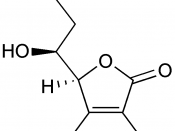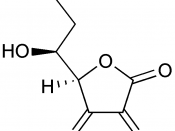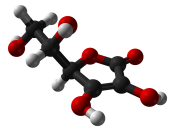Determination of Vitamin C by an Iodometric Titration
Purpose: The goal of this lab is to determine the concentration of vitamin C in juices and Real Lemon. A redox titration, involving an iodometric method, will be used to do the analysis. The samples will be classified by their Vitamin C content.
Introduction: Although most mammals can synthesize vitamin C, or ascorbic acid (C6H8O6), from sugars, man must ingest considerable quantities of this substance. The National Academy of Sciences recommends the consumption of 60 mg of ascorbic acid per day. Vitamin C deficiency, which typically causes abnormalities in bones and teeth, was first characterized in sailors in the eighteenth century. These abnormalities were eliminated by compelling sailors to eat limes, a source of vitamin C. Many vegetables also contain large quantities of vitamin C, but ascorbic acid is commonly destroyed by many cooking processes, and hence citrus fruits are regarded as the most reliable source of vitamin C.
Vitamin C can be determined in food by use of an oxidation-reduction reaction. The redox reaction is preferable to an acid-base titration because a number of other species in juice can act as acids, but relatively few interfere with the oxidation of ascorbic acid by iodine. The solubility of iodine is increased by complexation with iodide to form triiodide
I2 (aq) + I- úI3-
Triiodide then oxidizes vitamin C to dehydroascorbic acid
C6H8O6+ I3-+ H2O â C6H6O6+ 3I-+ 2H+(2)
Vitamin C dehydroascorbic acid The endpoint is indicated by the reaction of iodine with starch suspension, which produces a blue-black product. As long as vitamin C is present, the triiodide is quickly converted to iodide ion, and no blue-black iodine-starch product is observed. However, when all the vitamin C has been oxidized, the excess triiodide (in equilibrium with iodine) reacts with starch to...


